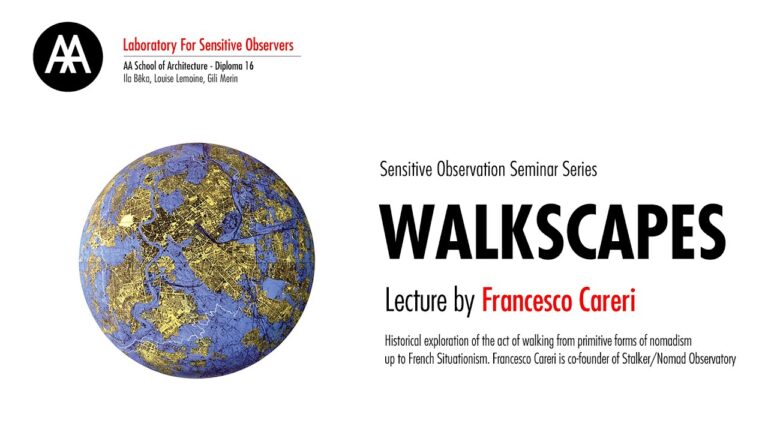
This masterclass is the 5th session of the Sensitive Observations Seminar Series hosted by AA Diploma Unit 16: Homo Urbanus taught by Ila Beka, Louise Lemoine & Gili Merin
Exactly 100 years ago, within the first step of DADA, the act of walking begins to be practiced as a form of Anti-Art. On 14 April 1921 in Paris, at three in the afternoon and in the pouring rain, the Dada movement had an appointment to trespass a barricade, jumping into the terrain vague of the church of Saint-Julien-le-Pauvre. This action was to be the first in a series of urban excursions to the banal places of the city. It is a conscious aesthetic operation backed up by press releases, proclamations, flyers and photographic documentation. André Breton recalled the project as a substantial failure: “Passing from the halls of spectacle to the open air will not suffice to put an end to the Dada recyclings.” In spite of Breton’s words, this first visit remains the most important Dada intervention in the city. The passage from the halls of spectacle to “the open-air” was, in fact, the first step in a long series of excursions, deambulations and “driftings” that crossed the entire century as a form of Anti-Art. This first Dada urban readymade marks the passage from art as a representation to art as a construction of a political and aesthetic action to be effected in the reality of everyday life.
The “visit” was one of the tools selected by Dada to achieve that surpassing of art that was to become the red thread for any understanding of the subsequent avant-gardes. In 1924 the Parisian Dadaists organized trips in the open country. They discovered a dream-like, surreal aspect of walking and defined this experience as “deambulation”, a sort of automatic writing in real space, capable of revealing the unconscious zones of space, the repressed memories of the city. At the beginning of the 1950s the Lettrist International, disputing Surrealist deambulation, began to construct that “Theory of Drifting” which, in 1956, at Alba, was to come into contact with the nomadic universe of the Roma People. In 1957 Constant designed a camp for the Sinti of Alba, while Asger Jorn and Guy Debord provided the first images of a city based on the dérive. Lettrist urban drifting was transformed into the construction of situations, experimenting with playful-creative behaviour and unitary environments. Constant reworked Situationist theory to develop the idea of a nomadic city—New Babylon—bringing the theme of nomadism into the sphere of architecture and laying the groundwork for the radical avant-gardes of the years to follow.
Francesco Careri is an Associate Professor of Urban and Architectural Design at Roma Tre University where he is co-director of Master Environmental Humanities and Master Performing Arts and Communitarian Spaces. He is co-founder of Stalker, with which since 1995 he experiments actions and research in the multicultural city. Since 2006 he runs the Civic Arts, a peripatetic laboratory grounded in walking explorations of emerging phenomena. He is currently scientific co-responsible together with Giovanni Caudo, of the Laboratorio di Città Corviale and together with Fabrizio Finucci of LaboratorioCIRCO. He published Constant. New Babylon, una Città Nomade, Testo & Immagine 2001; Walkscapes. Walking as an Aesthetic Practice, Editorial Gustavo Gili 2002, Culicidade 2016; Pasear, detenerse, Gustavo Gili 2016, and with Lorenzo Romito, Stalker/Campus Rom, Altrimedia 2017.
source